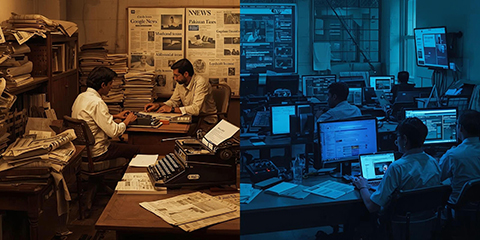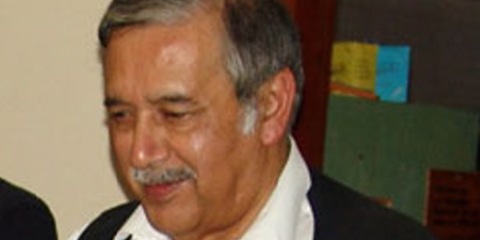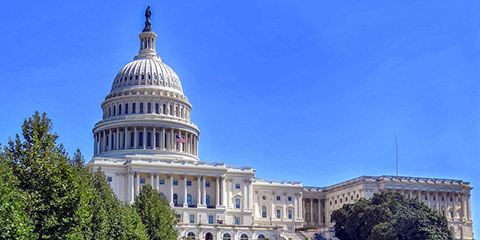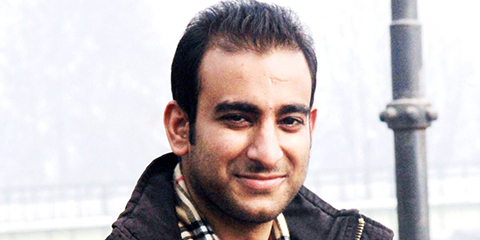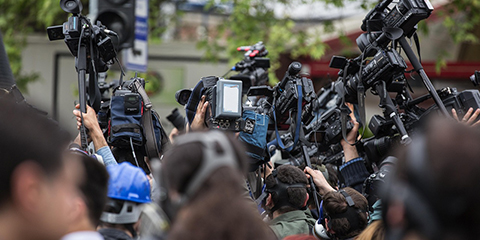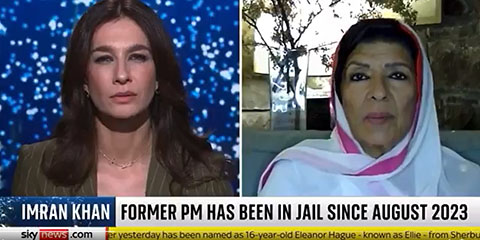Puppet Press: How Pakistan's media sold its soul to the highest bidder
JournalismPakistan.com | Published 9 months ago | JP Special Report
Join our WhatsApp channel
ISLAMABAD—Pakistan's media landscape has evolved significantly over the decades, yet legacy media outlets continue to face criticism for their shortcomings. This article explores the fundamental issues plaguing Pakistani journalism and why traditional media platforms often fail to meet public expectations.
1. Political Bias and Partisanship
Pakistan's media ecosystem suffers from rampant political bias, with many news channels and publications openly aligning themselves with specific political parties or ideologies. This partisanship undermines journalistic objectivity and erodes public trust in media reporting. Major news networks often become propaganda machines during election cycles, presenting one-sided narratives that serve political interests rather than informing citizens with balanced coverage.
Media analysts note that editorial independence has been compromised as ownership groups develop close relationships with political factions. This results in distorted news coverage where facts are cherry-picked to support predetermined narratives, leaving Pakistani audiences without access to impartial information necessary for democratic participation.
2. Corporate Influence and Advertising Pressures
The financial model of Pakistani journalism heavily relies on corporate advertising, creating a dangerous dependency that affects editorial decisions. Major business conglomerates exert significant influence over media content, often resulting in self-censorship on issues that might affect powerful advertisers.
Investigative journalists attempting to cover corporate misconduct frequently face resistance from their own management, as media owners prioritize advertising relationships over public interest reporting. This commercial pressure has effectively neutered the watchdog function of Pakistani media.
3. Sensationalism Over Substance
In the race for ratings and readership, Pakistan's legacy media frequently sacrifices journalistic integrity for sensationalism. News bulletins are filled with dramatic music, exaggerated headlines, and emotionally charged content designed to captivate rather than inform.
This tendency toward melodramatic reporting comes at the expense of nuanced analysis and fact-based journalism. Complex social, economic, and political issues are reduced to simplistic narratives or, worse, presented as entertainment. The preoccupation with sensationalism has particularly undermined coverage of crucial national issues like economic policy, climate change, and healthcare.
4. Military and Intelligence Influence
The relationship between Pakistan's media and security establishment remains problematic, with journalists facing both explicit and implicit pressure when covering military affairs or national security issues. Self-censorship is widespread when reporting on sensitive topics like defense spending, military operations, or intelligence activities.
5. Lack of Professional Training and Standards
The quality of journalism in Pakistan suffers from inadequate professional standards and training. Many practitioners enter the field without formal journalism education or training in ethical reporting practices. This results in basic journalistic errors, from factual inaccuracies to ethical violations like invasion of privacy or failure to verify sources.
Media organizations themselves often fail to invest in professional development for their staff, while industry bodies have been ineffective in establishing and enforcing journalistic standards. The consequence is a media landscape where professional excellence is rare, and substandard reporting is normalized.
6. Digital Transition Failures
Pakistan's legacy media has struggled to adapt to the digital revolution, with many established outlets failing to develop sustainable online strategies. Traditional newspapers and television networks have approached digital platforms as secondary channels rather than central to their future.
This technological lag means Pakistani journalism is losing relevance among younger, digitally-native audiences who increasingly turn to alternative sources for information. The failure to invest in digital innovation has left legacy media vulnerable to competition from social media and digital-native outlets, further eroding their influence and economic viability.
7. Urban Centrism and Regional Neglect
Pakistani journalism remains heavily metro-centric, with coverage disproportionately focused on major cities like Karachi, Lahore, and Islamabad. Rural areas and smaller cities receive minimal attention, creating significant information gaps about issues affecting most of Pakistan's population.
This geographic bias extends to regional languages, with Urdu and English media dominating the national discourse while regional-language journalism receives limited resources and recognition. Consequently, the diverse perspectives and concerns of Pakistan's many linguistic and cultural communities are inadequately represented in national media conversations.
8. Talk Show Culture Dominance
The Pakistani media landscape is dominated by political talk shows that prioritize heated debates over substantive discussion. These programs typically feature the same rotating cast of political commentators and party representatives engaged in confrontational exchanges that generate more heat than light.
This talk show culture has displaced investigative reporting and in-depth features, limiting the media's ability to perform essential journalistic functions like uncovering corruption or explaining complex policy issues. The result is a public discourse that is high on opinion but low on factual information and analysis.
9. Economic Unsustainability
The business model of Pakistan's legacy media has become increasingly unsustainable, leading to cost-cutting measures that further compromise journalistic quality. Declining advertising revenues have resulted in newsroom layoffs, reduced investigative budgets, and greater reliance on inexpensive content like wire stories and studio discussions.
This economic fragility makes media organizations vulnerable to financial pressure from government and corporate interests, further undermining editorial independence. Without viable economic models, Pakistani journalism struggles to maintain the resources necessary for quality reporting and long-term sustainability.
10. Regulatory Inconsistency and State Pressure
The regulatory environment for Pakistani media remains problematic, with unpredictable enforcement and politically motivated interventions. Government authorities have used advertising allocations, broadcast regulations, and legal mechanisms to reward supportive media outlets while punishing critical voices.
This inconsistent regulatory approach creates an environment of uncertainty where media organizations often err on the side of caution through self-censorship. The result is a narrowed range of permissible discourse and diminished capacity for the media to hold power accountable.
Pakistan's legacy media faces multiple systemic challenges that undermine its ability to serve as an adequate fourth pillar of democracy. Addressing these issues requires concerted efforts from media organizations, journalists, regulators, and civil society to build a more robust, ethical, and independent media ecosystem.
For journalism to fulfill its democratic potential in Pakistan, fundamental reforms are needed to address political influence, improve professional standards, develop sustainable business models, and embrace digital innovation. Until these changes occur, Pakistani audiences will continue to be disappointed by a media landscape that falls short of its essential purpose: to inform citizens and hold power accountable.
کٹھ پتلی پریس: کیسے پاکستانی میڈیا نے اپنے آپ کو بیچ دیا
پاکستان کا میڈیا منظرنامہ دہائیوں کے دوران نمایاں طور پر ارتقا پذیر ہوا ہے، لیکن روایتی میڈیا اداروں پر ان کی کمیوں کی وجہ سے تنقید جاری ہے۔ یہ مضمون پاکستانی صحافت کو متاثر کرنے والے بنیادی مسائل اور روایتی میڈیا پلیٹ فارمز اکثر عوامی توقعات پر پورا اترنے میں ناکام کیوں رہتے ہیں، کی وضاحت کرتا ہے۔
1. سیاسی تعصب اور جانبداری
پاکستان کا میڈیا ماحول بے تحاشا سیاسی تعصب سے متاثر ہے، بہت سے نیوز چینلز اور اشاعتیں کھلے عام خاص سیاسی پارٹیوں یا نظریات سے اپنی وابستگی رکھتے ہیں۔ یہ جانبداری صحافتی غیر جانبداری کو کمزور کرتی ہے اور میڈیا رپورٹنگ میں عوامی اعتماد کو کم کرتی ہے۔ بڑے نیوز نیٹ ورکس اکثر انتخابی مہمات کے دوران پروپیگنڈا مشینوں میں تبدیل ہو جاتے ہیں، جو متوازن کوریج کے ساتھ شہریوں کو معلومات فراہم کرنے کے بجائے سیاسی مفادات کی خدمت کرنے والی یک طرفہ روایات پیش کرتے ہیں۔
میڈیا تجزیہ کار نوٹ کرتے ہیں کہ ملکیتی گروپس کے سیاسی گروہوں کے ساتھ قریبی تعلقات کی وجہ سے ادارتی آزادی سے سمجھوتا کیا گیا ہے۔ اس کا نتیجہ خبروں کی تحریف شدہ کوریج میں نکلتا ہے جہاں پہلے سے طے شدہ روایات کی حمایت کے لیے حقائق کو چھانٹا جاتا ہے، جس سے پاکستانی سامعین کو جمہوری شرکت کے لیے ضروری غیر جانبدار معلومات تک رسائی نہیں ملتی۔
2. کارپوریٹ اثر اور اشتہارات کا دباؤ
پاکستانی صحافت کا مالیاتی ماڈل بڑی حد تک کارپوریٹ اشتہارات پر انحصار کرتا ہے، جس سے ایک خطرناک انحصار پیدا ہوتا ہے جو ادارتی فیصلوں کو متاثر کرتا ہے۔ بڑے کاروباری مجموعے میڈیا مواد پر نمایاں اثر ڈالتے ہیں، جس کا اکثر نتیجہ ان مسائل پر خودسینسرشپ کی صورت میں نکلتا ہے جو طاقتور اشتہار دہندگان کو متاثر کر سکتے ہیں۔
کارپوریٹ غلط کاموں کی کوریج کرنے والے تحقیقاتی صحافیوں کو اکثر اپنے ہی انتظامیہ کی طرف سے مزاحمت کا سامنا کرنا پڑتا ہے، کیونکہ میڈیا مالکان عوامی مفاد کی رپورٹنگ پر اشتہاری تعلقات کو ترجیح دیتے ہیں۔ اس تجارتی دباؤ نے پاکستانی میڈیا کے نگران فنکشن کو بے اثر کر دیا ہے، خاص طور پر ماحولیاتی خلاف ورزیوں، مزدوروں کے استحصال، یا بااثر کمپنیوں کے مشکوک کاروباری طریقوں جیسے مسائل کی کوریج کرتے وقت۔
3. سنسنی خیزی پر مواد کو ترجیح
ریٹنگ اور قارئین کی دوڑ میں، پاکستان کا روایتی میڈیا اکثر سنسنی خیزی کے لیے صحافتی سالمیت کی قربانی دیتا ہے۔ نیوز بلیٹن ڈرامائی موسیقی، بڑھا چڑھا کر پیش کیے گئے سرخیوں، اور جذباتی طور پر چارج کردہ مواد سے بھرے ہوتے ہیں جو معلومات دینے کی بجائے گرفتار کرنے کے لیے ڈیزائن کیے گئے ہیں۔
ڈرامائی رپورٹنگ کی یہ رجحان پیچیدہ تجزیہ اور حقائق پر مبنی صحافت کی قیمت پر آتا ہے۔ سماجی، معاشی، اور سیاسی پیچیدہ مسائل کو سادہ روایات میں تبدیل کر دیا جاتا ہے یا، بدتر، تفریح کے طور پر پیش کیا جاتا ہے۔ سنسنی خیزی کی مشغولیت نے خاص طور پر معاشی پالیسی، موسمیاتی تبدیلی، اور صحت کی دیکھ بھال کی اصلاحات جیسے اہم قومی مسائل کی کوریج کو کمزور کیا ہے۔
4. فوج اور انٹیلیجنس کا اثر
پاکستان کے میڈیا اور سیکیورٹی اسٹیبلشمنٹ کے درمیان تعلقات مسئلہ خیز رہتے ہیں، صحافیوں کو فوجی امور یا قومی سلامتی کے مسائل کی کوریج کرتے وقت واضح اور مضمر دونوں دباؤ کا سامنا کرنا پڑتا ہے۔ حساس موضوعات جیسے دفاعی اخراجات، فوجی آپریشنز، یا انٹیلیجنس سرگرمیوں کی رپورٹنگ کرتے وقت خود سینسرشپ وسیع پیمانے پر موجود ہے۔
5. پیشہ ورانہ تربیت اور معیارات کی کمی
پاکستان میں صحافت کا معیار ناکافی پیشہ ورانہ معیارات اور تربیت سے متاثر ہوتا ہے۔ بہت سے ماہرین باضابطہ صحافت کی تعلیم یا اخلاقی رپورٹنگ کے طریقوں کی تربیت کے بغیر اس شعبے میں داخل ہوتے ہیں۔ اس کا نتیجہ بنیادی صحافتی غلطیوں میں نکلتا ہے، حقائق کی غلطیوں سے لے کر رازداری کی خلاف ورزی یا ذرائع کی تصدیق میں ناکامی جیسی اخلاقی خلاف ورزیوں تک۔
میڈیا تنظیمیں خود اکثر اپنے عملے کی پیشہ ورانہ ترقی میں سرمایہ کاری کرنے میں ناکام رہتی ہیں، جبکہ صنعتی اداروں نے صحافتی معیارات کو قائم کرنے اور نافذ کرنے میں غیر موثر کردار ادا کیا ہے۔ نتیجہ ایک ایسا میڈیا منظرنامہ ہے جہاں پیشہ ورانہ امتیاز نایاب ہے، اور معیار سے کم رپورٹنگ کو عام کر دیا گیا ہے۔
6. ڈیجیٹل تبدیلی کی ناکامیاں
پاکستان کا روایتی میڈیا ڈیجیٹل انقلاب کے ساتھ تطابق کرنے میں مشکلات کا شکار رہا ہے، بہت سے قائم شدہ اداروں کو پائیدار آن لائن حکمت عملیاں تیار کرنے میں ناکامی کا سامنا ہے۔ روایتی اخبارات اور ٹیلی ویژن نیٹ ورکس نے ڈیجیٹل پلیٹ فارمز کو اپنے مستقبل کے مرکزی حیثیت کی بجائے ثانوی چینلز کے طور پر استعمال کیا ہے۔
یہ تکنیکی خلیج کا مطلب ہے کہ پاکستانی صحافت نوجوان، ڈیجیٹل پیدائشی سامعین کے درمیان متعلقہ کھو رہی ہے جو تیزی سے معلومات کے لیے متبادل ذرائع کا رخ کرتے ہیں۔ ڈیجیٹل جدت میں سرمایہ کاری کرنے میں ناکامی نے روایتی میڈیا کو سوشل میڈیا اور ڈیجیٹل نیٹو آؤٹ لیٹس سے مقابلہ کے لیے کمزور چھوڑ دیا ہے، جس سے مزید ان کا اثر و رسوخ اور معاشی استحکام کم ہوا ہے۔
7. شہری مرکزیت اور علاقائی نظر انداز
پاکستانی صحافت بڑی حد تک میٹرو مرکزی رہتی ہے، کوریج غیر متناسب طور پر کراچی، لاہور، اور اسلام آباد جیسے بڑے شہروں پر مرکوز ہوتی ہے۔ دیہی علاقوں اور چھوٹے شہروں کو کم سے کم توجہ ملتی ہے، جس سے پاکستان کی آبادی کی اکثریت کو متاثر کرنے والے مسائل کے بارے میں نمایاں معلوماتی خلا پیدا ہوتا ہے۔
یہ جغرافیائی تعصب علاقائی زبانوں تک بھی پھیلتا ہے، اردو اور انگریزی میڈیا قومی گفتگو پر غالب ہیں جبکہ علاقائی زبان کی صحافت کو محدود وسائل اور تسلیم حاصل ہوتی ہے۔ نتیجتاً، پاکستان کی بہت سی لسانی اور ثقافتی برادریوں کے متنوع نقطہ نظر اور خدشات قومی میڈیا کی گفتگو میں ناکافی طور پر نمائندگی کرتے ہیں۔
8. ٹاک شو کلچر کی بالادستی
پاکستانی میڈیا کا منظرنامہ سیاسی ٹاک شوز پر غالب ہے جو با مقصد بحث کے بجائے گرم بحثوں کو ترجیح دیتے ہیں۔ ان پروگراموں میں عام طور پر سیاسی تبصرہ نگاروں اور پارٹی نمائندوں کا وہی گھومنے والا گروہ شامل ہوتا ہے جو ٹکراؤ کے تبادلوں میں مصروف رہتے ہیں جو روشنی سے زیادہ حرارت پیدا کرتے ہیں۔
اس ٹاک شو کلچر نے تحقیقاتی رپورٹنگ اور گہری خصوصیات کو بے دخل کر دیا ہے، بدعنوانی کا پتہ لگانے یا پیچیدہ پالیسی کے مسائل کی وضاحت کرنے جیسے ضروری صحافتی افعال کو انجام دینے کی میڈیا کی صلاحیت کو محدود کر دیا ہے۔ نتیجہ ایک عوامی گفتگو ہے جو رائے پر زیادہ لیکن حقائق پر مبنی معلومات اور تجزیہ پر کم ہے۔
9. معاشی غیر استحکام
پاکستان کے روایتی میڈیا کا کاروباری ماڈل تیزی سے غیر پائیدار ہوتا جا رہا ہے، جس سے لاگت میں کٹوتی کے اقدامات کیے جاتے ہیں جو مزید صحافتی معیار سے سمجھوتہ کرتے ہیں۔ اشتہارات سے آمدنی میں کمی کے نتیجے میں نیوز روم میں چھٹنی، تحقیقاتی بجٹ میں کمی، اور وائر اسٹوریز اور اسٹوڈیو مباحثوں جیسے سستے مواد پر زیادہ انحصار ہوا ہے۔
یہ معاشی کمزوری میڈیا تنظیموں کو حکومتی اور کارپوریٹ مفادات کے مالی دباؤ کے سامنے کمزور بناتی ہے، جو مزید ادارتی آزادی کو کمزور کرتی ہے۔ قابل عمل معاشی ماڈلز کے بغیر، پاکستانی صحافت معیاری رپورٹنگ اور طویل مدتی استحکام کے لیے ضروری وسائل کو برقرار رکھنے کے لیے جدوجہد کرتی ہے۔
10. ریگولیٹری عدم استحکام اور ریاستی دباؤ
پاکستانی میڈیا کے لیے ریگولیٹری ماحول مسئلہ خیز رہتا ہے، غیر متوقع نفاذ اور سیاسی طور پر حوصلہ افزائی کی مداخلت کے ساتھ۔ حکومتی حکام نے اشتہارات کی تخصیصات، نشریاتی ضوابط، اور قانونی طریقوں کا استعمال حمایتی میڈیا آؤٹ لیٹس کو انعام دینے اور تنقیدی آوازوں کو سزا دینے کے لیے کیا ہے۔
یہ غیر مستحکم ریگولیٹری طریقہ کار عدم یقینی کا ماحول پیدا کرتا ہے جہاں میڈیا تنظیمیں اکثر خود سینسرشپ کے ذریعے احتیاط کی طرف جھکتی ہیں۔ نتیجہ قابل اجازت گفتگو کی حد میں کمی اور طاقت کو جوابدہ ٹھہرانے کے لیے میڈیا کی صلاحیت میں کمی ہے۔
پاکستان کا روایتی میڈیا متعدد نظامی چیلنجوں کا سامنا کرتا ہے جو جمہوریت کے موثر چوتھے ستون کے طور پر خدمت کرنے کی اس کی صلاحیت کو کمزور کرتے ہیں۔ ان مسائل کا حل میڈیا تنظیموں، صحافیوں، ریگولیٹرز، اور سول سوسائٹی کی طرف سے مشترکہ کوششوں کی ضرورت ہے تاکہ ایک مضبوط، اخلاقی، اور آزاد میڈیا ماحول تعمیر کیا جا سکے۔
پاکستان میں صحافت کو اپنی جمہوری صلاحیت کو پورا کرنے کے لیے، سیاسی اثر و رسوخ کو حل کرنے، پیشہ ورانہ معیارات کو بہتر بنانے، پائیدار کاروباری ماڈل تیار کرنے، اور ڈیجیٹل جدت کو اپنانے کے لیے بنیادی اصلاحات کی ضرورت ہے۔ جب تک یہ تبدیلیاں نہیں ہوتیں، پاکستانی سامعین ایک ایسے میڈیا منظرنامہ سے مایوس ہوتے رہیں گے جو اپنے ضروری مقصد سے کم ہے: شہریوں کو معلومات فراہم کرنا اور طاقت کو جوابدہ ٹھہرانا۔






